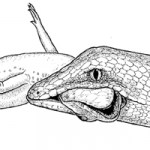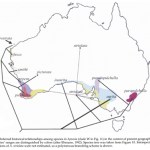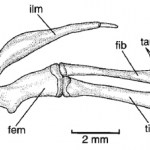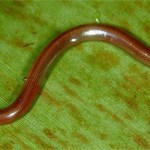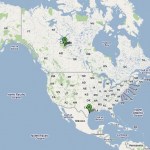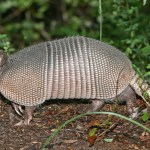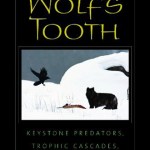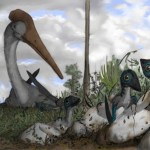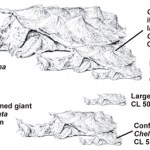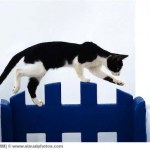Life Sciences
In the previous article I provided brief reviews of all currently recognised pygopodid 'genera'*. Except one. I've left this one until last, largely because it's the most spectacular (up to 75 cm in total length) and (arguably) most fascinating pygopodid. We've seen throughout this series of articles that pygopodids are convergent with certain snake groups, and may in fact have been so successful at filling up ecological niches occupied elsewhere by colubroid snakes that they effectively prevented such snakes from evolving: you can imagine this as the 'pygopodids got there first' hypothesis…
I really want to get these pygopodid articles finished. Actually, I really want to get the whole gekkotan series finished: the end is in sight and I know I'll get there eventually. In the previous articles on pygopodids (part of the long-running series on gekkotan lizards: see links below), we looked at pygopodid diversity and biology in general, and also at the phylogeny and evolutionary history of these fascinating, snake-like gekkotans. This time round, we look in more detail at the various different pygopodid taxa - not on a species-by-species basis (alas), but according to the units we…
The previous article - part of my now lengthy series on gekkotan squamates (see links below) - provided an introduction to the neat and fascinating near-limbless Australasian gekkotans known as the pygopodids. Disclaimer: the group being discussed here is 'Pygopodidae of tradition', not Pygopodidae as currently formulated. More on this matter later.
One topic that I didn't explore fully in the previous article is pygopodid diversity. These reptiles aren't all samey little generalists; species within the group practise several different lifestyles and foraging behaviours, and the amount of…
I'm sitting here looking at Antarctic Wildlife: A Visitor's Guide. I've never been to the Antarctic so I can't tell you what I think of this book from the pragmatic angle of how well it works as a guide, but I can tell you that I've learned a number of things just looking at the book. For one thing, I had no idea that almost all tourist visits to Antarctica go to the same general area of the continent. I guess that makes sense given the geography of the region, but it had not occurred to me before.
I've guided a number of tours in Africa and some of my clients were very serious world…
One of my shortish-term goals at Tet Zoo has been to complete the series on gekkotan lizards I started in April 2010 (see below for links to previous parts). We continue with that series here, and this time round we're going to look at what should definitely be regarded as the weirdest of gekkotans: the near-limbless pygopodids, pygopods or flap-footed lizards, all of which inhabit Australia and New Guinea (and at least some of the surrounding islands). Because there's a lot to say about them, the article you're reading is the first of three. [Excellent paintings below by Alan Male, from…
Dibamids are a weird and very neat group of fossorial, near-limbless squamates that I've long planned to cover at Tet Zoo. Little is known about them and how they might relate to other squamates has long been the subject of debate (they might be close to amphisbaenians, but links with gekkotans, skinks and snakes have all been suggested in the past). I'm going to avoid saying much about them here: I just want to point to the fact that a newly named species - Dibamus dalaiensis Neang et al., 2011 [shown here; image Thy Neang/Flora & Fauna International] - extends their distribution to…
When wildebeest, such as those famous for crossing the Mara River in Tanzania during their annual migration, run into a crocodile or some other danger it is often the first time they've seen that particular thing. This is because most wildebeest don't live very long so many are on their very first migration. One wonders what would happen if you killed all of the wildebeest migrating in a particular year and set new ones out on the landscape to take their place. Would the migration continue?
Probably not, initially. Something like this did in fact happen on the Botswana-South Africa-…
"If the Universe Is Teeming with Aliens... Where Is Everybody?" -Stephen Webb
As egocentric as we are, we know that not only are we but one planet of many orbiting our Sun, but that when we look up in the heavens, every point of light we see is another chance -- another opportunity -- for planets, for life, and even for intelligence.
Image credit: Ned Wright, COBE / DIRBE, and NASA.
With hundreds of billions of stars (visible here in infrared wavelengths) in our galaxy alone, we have many, many chances for life to have evolved similarly to how it did here on Earth. With hundreds of billions…
The Rap Guide to Evolution Music Videos, sponsored by the Wellcome Trust.
I've been exploring the use of rap and pop culture to teach science and mathematics, ranging from Lupe Fiasco to Linkin Park, but that topic is for another day. But anyone interested in evolution, whether student or teacher, could find this "Evolution Rap" a refreshing approach.
Bottom line: learning should always be this fun.
Lyrics:
"Yo, yo, the Origin of Species
Ain't no feces, dawg, believe me..."
And that's all I could think of
So then I thought, this needs to be re-written
By looking at the similarities in…
They used to hunt whooping cranes. Between that and habitat loss, the number dropped from nearly 20,0000 to a mere 1,400 during the first half of the 19th century, and continued to drop to an all time low of 15 birds in 1941.
Fifteen birds, in 1941, represented the entire species.
All those birds were members of a single flock that migrated between the Aransas National Wildlife Refuge in Texas, USA and Wood Buffalo National Park in Canada.
Most people know the story, or at least, the vague outlines of the story. Much has been written about them, including several books such as Cranes:…
On the Move: How and Why Animals Travel in Groups, edited by Sue Boinski and Paul Garber is a compendium of academic research on ... well, on how and why animals travel in groups. Notice of this book is a fitting start to a series of reviews of migration-related books that is part of Migration Week on GLB. (For an overview of the Bigness and Vastness of bird migration in particular, see A Question of Migration.)
Group movement is only rarely migration, though the two phenomena are overlapping subsets. An example of group movement that demands some explanation is that found in chimpanzees…
Ebola has long been associated with wildlife. From the early days, bats were viewed as a potential reservoir (though it wasn't confirmed that they actually harbored the virus until 2005). Contact with wild animals--particularly primates which were butchered for food--was also long thought to be a risk factor, and now we know that primates can become ill with Ebola and pass the virus to humans.
What hadn't been examined until 2008 were pigs. I mean, it's not exactly the animal you associate with central Africa, where many of the Ebola cases have been concentrated. However, pigs are much more…
If asked "Why do giraffes have such long necks?", the majority of people - professional biologists among them - will answer that it's something to do with increasing vertical reach and hence feeding range. But while the 'increased vertical reach' or 'increased feeding envelope' hypothesis has always been the most popular explanation invoked to explain the giraffe's neck, it isn't the only one.
In 1996, Robert Simmons and Lue Scheepers argued that the giraffe neck functions as a sexual signal: they said that the necks of males are bigger and thicker than those of females, that the necks of…
Image Source: tsuru-bird.net
The low body temperature of armadillos is thought to contribute to their susceptibility to infection with the bacteria responsible for causing leprosy, Mycobacterium leprae. In fact, armadillos were intentionally inoculated with the bacteria in the 1960's to allow researchers to learn more about this disease and to develop treatments. In 1975, researchers discovered wild armadillos with leprosy but transmission of the disease to humans was considered unlikely. That may be changing...
Thanks to gene typing technology, researchers have found that the genotype of…
Human infants have one important job during the first years of life, and that is to learn about the world and their culture from their parents and other caregivers. But what is learning? I've previously written that Hungarian developmental psychologists Gergely and Csibra have defined learning as the acquisition of new, generalizable knowledge that can later be used within a new context. Further, they have posited that evolution has prepared humans to learn generalizable knowledge from their caregivers. They proposed an elegant hypothesis: that a specialized innate pedagogy mechanism - called…
The interconnectedness of ecosystems and their components is, today, a familiar concept. Top predators eat herbivores, herbivores eat plants, and top predators keep so-called meso-predators in check too. But perhaps it isn't appreciated enough just how interconnected things can be. Cristina Eisenberg's excellent 2010 book The Wolf's Tooth: Keystone Predators, Trophic Cascades and Biodiversity draws on decades of ecological research to paint a complex picture of ecosystem interactions and cascades, of the crucial role of top predators, and of human impact on communities in the natural world.…
In January 2011, Junchang Lü, David Unwin, Charles Deeming and colleagues published their Science paper on the amazing discovery of an egg-adult association in the Jurassic pterosaur Darwinopterus (Lü et al. 2011) [the specimen is shown here: image courtesy of Junchang Lü, Institute of Geology, Beijing, used with permission]. Darwinopterus is the incredible 'transitional pterosaur', first unveiled to the world in October 2009 and rapidly becoming one of the most important pterosaurs of all in terms of what we're learning from it.
As I discussed in a Tet Zoo article published in February…
If you're a regular reader you'll have seen the recent article on those African 'great bubalus' depictions and on how they might (or might not) be representations of the large, long-horned bovin bovid Syncerus antiquus. As discussed in that article, S. antiquus - long thought to be a species of Pelorovis - is now regarded as a very close relative of S. caffer, the living Cape buffalo. As usual though, there are quite a few additional things that I wanted to cover, so here's an attempt to tie up various loose ends [the illustrations above show radically different reconstructions of…
The Matamata is an incredible animal. A morphologically bizarre, highly cryptic, aquatic South American turtle, it's equipped with a super-specialised wide, flattened skull and a host of peculiar features that allow it to engulf fish and other prey in deft acts of rapid suction.
Surprisingly large (up to 1 m long), it has a very long, thick neck, and a proboscis that it uses as a snorkel. But of course you already know all of this because I covered it in depth in a series of articles published here during 2010 (if you need a refresher, see the links given below). My aim in this fifth and…
Cats are no doubt one of the most graceful and athletic animals. Researchers from Drexel University, Georgia Institute of Technology, and the University of Manitoba, Winnipeg, Canada have developed a computational model of hindlimb locomotion for a cat. Locomotion is controlled by central pattern generators, which are groups of motor neurons within the spinal cord that control coordinated movements like walking. A website showing this model in action can be viewed here.
Studying how cats walk may provide tools to improve the understanding of locomotion in other species. It may also help in…
